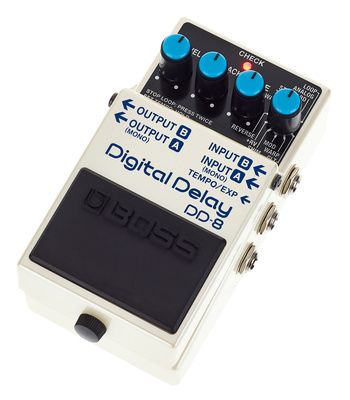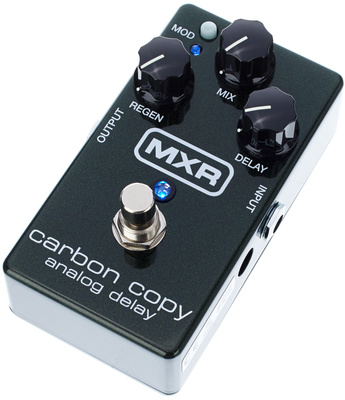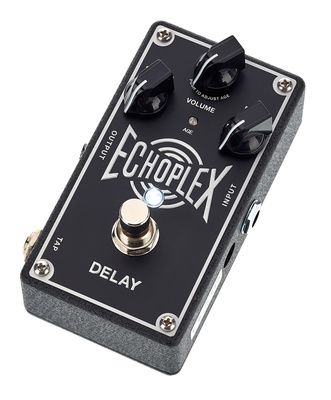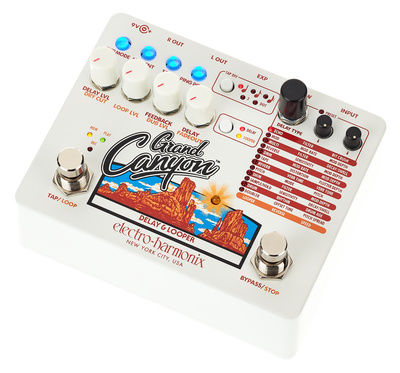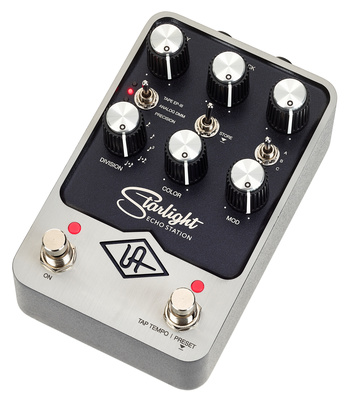The five best delay pedals
Delay effects are among the most popular types of effects in music. They are often used with guitars. In today's article, we'll explain what delay effects are and introduce our five favorite delay pedals.
What exactly is a delay?
A delay is essentially an echo added to a sound. This artificial echo adds atmosphere and depth to your sound. The name "delay" refers to what the pedal does: it repeats the input signal at short intervals.
The three most common types of delay are acoustic, mechanical, and electronic. An acoustic delay is simply an echo in the physical world. For example, when you shout "hello" in a canyon, the sound comes back to you with a delay. This type of delay is, of course, irrelevant in practice for the guitar.
Originally, delay in music was produced mostly mechanically. Today, however, almost all delays are electronic because these devices are much more practical than mechanical ones.
What types of delay pedals are there?
Delay effects for guitars can be divided into three categories.
Digital delay: With digital delay, the echo is generated by a software algorithm. These pedals are essentially small computers. Digital delay is the most popular type of electronic delay today, and for good reason: software is simply much more flexible than hardware.
Digital delays also offer a clarity of sound that other types of delays can only dream of. Latency, or the time it takes for the sound to be generated, is usually lower with digital delays.
Analog delay: With analog delays, the echo is generated by an analog circuit; therefore, they also belong to the category of electronic delays. Although digital delays are the more "modern" option these days, analog delays are still frequently used. They are particularly valued for their warm, natural sound.
However, they are less flexible than digital delays and produce a less clear sound because the circuits often cause minor noise or interference.
Tape Delay: Tape delay is the most common mechanical type of guitar delay. Sound is transferred to magnetic tape and then played back at different intervals. This type of delay is hardly used today.
We don't recommend it either because devices of this type are impractical and bulky. However, electronic delays simulate the sound of tape devices.
Delay effects: Our five favorites
Below, we present our five current favorites in the field of delay effects. This does not mean that these are the absolute best-sounding devices. We also want to show you devices from different price ranges, not just those affordable for professionals.
Please note that delay effect pedals are generally more expensive than devices in other categories. Even cheaper delays often cost around $100. If you are setting up your first guitar rig on a limited budget, we recommend purchasing a good distortion/overdrive and reverb first.
Boss DD-8
The Boss DD-8 is an affordable, all-around pedal that produces high-quality delay sounds. It comes in white and features the classic Boss pedal design with a black tread and logo. The DD-8 is a digital stereo delay that offers eleven different delay modes and simple looper functions.
It has knobs for level, feedback, time, and mode and is compact and lightweight at 440 grams. It is powered by a 9V block battery or an optional power supply.
Considering its price of around $170, the DD-8 offers very decent sound quality and flexible adjustment options. Overall, it's a good device for beginners.
MXR M169 Carbon Copy
Priced at around $160, the MXR M169 Carbon Copy falls within the same price range as the DD-8 from Boss. The big difference is that the Carbon Copy is an analog delay pedal. MXR has been around since the 1970s and remains one of the largest delay pedal manufacturers today. One of the most famous guitarists to use an MXR pedal was Eddie Van Halen.
The M169 has three knobs for adjusting the mix, the number of echoes, and the echo timing. Additionally, a button activates a modulation mode that adds depth to the sound. The compact device fits on any pedalboard. It is powered by a 9V battery or a separate power supply, which is sold separately. True bypass is supported.
The device's analog sound is reminiscent of the '70s and '80s—no wonder, since it is a modern version of a popular MXR pedal from that time. If you want an analog delay sound for playing pop or rock, you should definitely consider the Carbon Copy.
Dunlop Echoplex
With a price tag of around $250, the Echoplex from Dunlop is a digital delay more suited to advanced users. It has a metal housing with a stylish black panel on top. This fairly compact device has three controls for delay, sustain, and volume. The delay time can be adjusted from 40 to 750 milliseconds.
The Dunlop delay is powered by the included power supply. Unfortunately, battery operation is not possible. However, the Echoplex offers true bypass and a switch that allows you to switch between mono and stereo.
A special feature of the Echoplex is its ability to produce a successful mix of analog and digital delay sounds. There is also an Age mode that allows you to produce a variety of delay sounds. While the Echoplex is not the cheapest delay pedal, we believe its outstanding sound quality makes it more than worth the money.
Electro Harmonix Grand Canyon
With a price tag of €250, the Grand Canyon is neither the cheapest nor the most compact digital delay. However, this device offers an incredible variety of delay sounds. Its white housing features a striking Grand Canyon illustration and a plethora of controls that allow you to customize the sound to your liking.
The device has twelve built-in delay types, including tape delay simulations, and can handle delay times of up to three seconds. The effect types are conveniently labeled directly on the housing. You can also customize the thirteen built-in presets and connect an external footswitch. Did we mention that the Grand Canyon is also a useful looper?
In terms of customizability, the Grand Canyon leaves little to be desired. But is the sound convincing? We think so. We believe that you can't go wrong purchasing an Electro-Harmonix Grand Canyon.
Universal Audio UAFX Starlight Echo Station
When a small stomp box costs $350, it had better offer a lot. That's definitely the case with the Starlight Echo Station from Universal Audio. The device has a stylish black-and-gray housing and six knobs and three additional toggle switches that offer great flexibility.
The Echo Station has a lot more to offer than just lots of controls, though. You can save your settings as presets and connect the delay to a computer via USB-C to install firmware updates and download additional effects. The Echo Station has delay simulations from all three categories: tape, analog, and digital. Among other things, it simulates the original Echoplex, the device we introduced above.
And the sound? As you would expect from Universal Audio, it's outstanding. If you're not familiar with the brand, Universal Audio is primarily known for its professional studio technology and effects. The Starlight Echo Station is therefore ideal for those who want professional-grade delay sound and are willing to pay for it.
Conclusion
As we wrote in our beginner's guide to effects pedals: In our opinion, a delay pedal is not the highest priority for your pedalboard when you're just starting out. However, in the medium term, every guitarist should have one because a good delay pedal can significantly enhance your sound. We hope we've given you a brief overview of delays that you can explore further.
